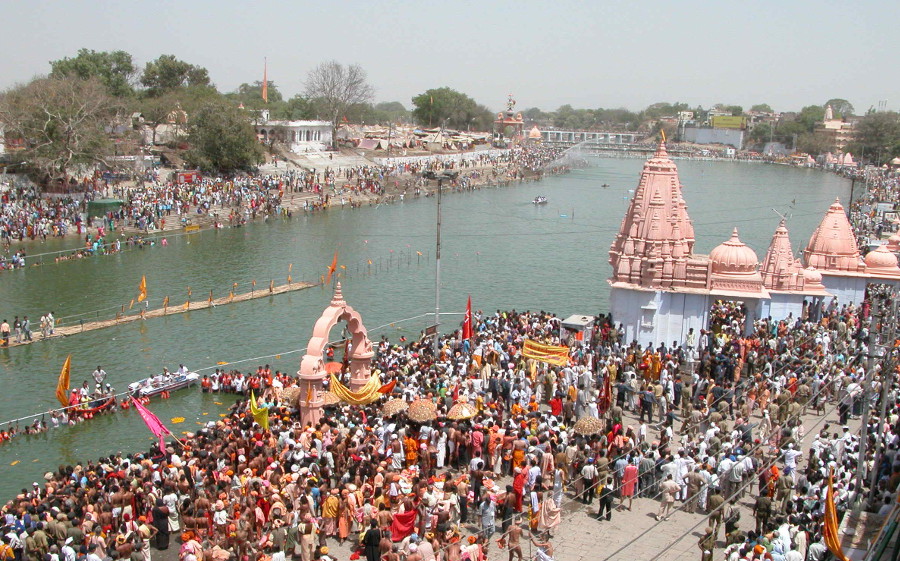Kumbha Mela is the world’s largest religious fair. It is not only a display of supremacy of the Bharatiya culture, but is also a spiritual congregation that provides satsang. The Kumbha Mela held every 12 years at Prayag, Haridwar, Ujjain and Tryambakeshwar-Nashik on the occasion of the Kumbha Parva has an important place in the Hindu civilization. The spiritual glory and cultural importance of the Kumbha Parva is unique.
Simhastha Parva at Ujjain
This Holy place is situated on the banks of Kshipra River in Madhya Pradesh. This has been called ‘Mahakalvan’ in Skandapurana. Historically this Holy place is popularly known by many names like Avantika, Suvarnashrung, Kushsthali, Kanak-shrunga, Vishala, Bhogwati, Padmavati, Pratikalpa, Ujjaini and Avanti. Ujjain is also famous for the direction of Tropic of Cancer.
1. Origin
In the ancient times, Deity Shiva conquered Tripurasura at this place. Hence, this Holy place is called ‘Ujjayini’, says Avantyakhand in Skandapurana.
2. Significance of the Holy place of Ujjain
1. One of the seven cities which bestows Moksha : Avantika or Ujjain is one of the seven cities (of Ayodhya, Mathura, Maya etc.) known for bestowing Moksha to man.
2. Navel region of the body of Holy places : If all the Holy places are considered to be a body, Avantika is in its navel region. This has been mentioned in Varahapurana.
3. One of the twelve Jyotirlingas : The Jyotirlinga (Powerful Divine lingas, that is, sacred symbols of Deity Shiva) called Mahakal of the twelve Jyotirlingas is in Ujjain. Devotees believe that by having darshan (Sight) of Mahakal, untimely death is averted and one also attains liberation.
4. One of the fifty-one Shaktipeethas : There is an ancient temple of Harasiddhidevi here. Since Sati Parvati’s elbow fell here, it is considered to be one of the fi fty-one Shaktipeethas (Seats of Divine Energy). Therefore, more than the Idol, its elbow is worshipped in this temple.
3. Simhastha Kumbha Parva of Ujjain
When Jupiter is in Leo and Sun is in Aries, Simhastha Kumbha Parva is held in Ujjain. On the day of Vaishakha Pournima since it is Parvakal Rajyogi snan (Shahisnan) (Holy bath) is taken. Holy bath is also taken on Chaitra Pournima, Chaitra Amavasya, Akshayya Trutiya, and Ekadashi. The bath in River Kshipra in Ujjain in the month of Vaishakha is considered to be more Holy. Merits similar to that obtained by staying in Varanasi for many years are obtained by staying here for 5 days in the month of Vaishakha.
प्रयागे माघमासे तु पुष्करे कार्तिके तथा ।
अवन्त्यां माधवे मासे पापं हन्यात् युगार्जितम् ॥
– Skandapuran
Meaning : If you take a Holy bath in the month of Magha at Prayag, in the month of Kartik at Pushkar and in the month of Vaishakha at Ujjain, sins of many Yugas will be washed away.
A. Significance of Simhastha Kumbha Parva
कुशस्थली तीर्थवरं देवानामपि दुर्लभम् ।
माधवे धवले पक्षे सिंहे जीवे त्वजे रवौ ॥
तुलाराशौ क्षपानाथे स्वातिभे पूर्णिमातिथौ ।
व्यतिपाते तु सम्प्राप्ते चन्द्रवासरसंयुते ।
एते दश महायोगा: स्नानान्मुक्तिफलप्रदाः ॥
– Simhastha Mahatmya, Shloka 36 to 38
Meaning : If we take a Holy bath during the following ten Mahayogas – 1. Kushasthali tirtha (Ujjain), 2. Vaishakha month, 3. Shukla Paksha, 4. Jupiter in the Sun sign, 5. Sun in the Aries sign, 6. Moon in the Libra sign, 7. Swati Nakshatra, 8. Pournima tithi, 9. Vyatipat yoga, 10. Monday, we obtain Moksha. Of the above, many Mahayogas fall during the Simhastha Maha Parva.
4. Temples in Ujjain
Ujjain is famous for important temples such as Shri Mahakaleshwar Temple, Shri Harsiddhidevi Temple and Shri Mangalnath Temple. Puranas say that Ujjain is the birth place of Mangal (Mars planet); hence, devotees in whose horoscope Mangal is strong, throng this place and perform worship etc.
E. Navagraha Triveni (Shani Temple)
A. Shri Mahakaleshwar Temple
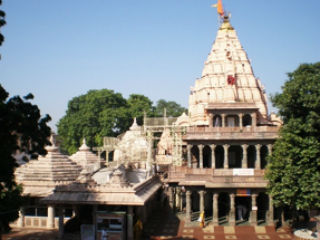
The presiding deity of time, Shiva, in all his splendour reigns eternal in Ujjain. The temple of Mahakaleshwar, its shikhara soaring into the skies, evokes primordial awe and reverence with its majesty. The Mahakal dominates the life of the city and its people, even in the midst of the busy routine of modern preoccupations, and provides an unbreakable link with past traditions….
{The temple is three-storeyed. In the lowest middle and uppermost parts are respectively installed the lingams of Mahakalesvara, Omkareshwar and Nagachandresvara.The pilgrims and the visitors can only have the glimpse of Nagachandresvara on the festive of Naga Panchami. A very large-sized Kunda named Koti Tirtha also exists in the temple-complex. The Kunda is built in the sarvatobhadra style. The Kunda and its water both are treated as very celestial. On the path adjoining the stairs of the Kunda, may be seen many images representing the sculptural grandeur of the temple built during the Paramara period. In the east of the Kunda is a large-sized Veranda in which there is the entrance to the path leading to the garbhagrha. In the northern side of the verandah, in a cell, the images of Sri Rama and goddess Avantika are worshipped. In the southern side of the main shrine, there stand many small Saivite temples built during the shinde regime among these the temple of Vrddha Mahakalesvara, Anadi Kalpesvara and Saptarshi are prominent and are the remarkable pieces of architecture.
The lingam of Mahakalesvara is colossus. The silver plated Naga Jaladhari and the inscribed and esoteric silver-plate covering the roof of the garbhagrha add extra grandeur to the shrine. Besides Jyotirlinga, attractive and small-sized images of Ganesa, Kartikeya and Paravati can be seen in the garbhagrha. All around the walls classical eulogies in the praise of Lord Siva are exhibited. The Nanda Dipa always remains lit. In the exit-path, there is a wide hall in which a most attractive metal quoted stone Nandi, in the sitting humble pose may be witnessed. The courtyard just opposite to the Omkaresvara temple add much to the magnanimity of the temple-complex. Just adjoining to this temple, there are two pillared projections facing the east and adding a lot to the architecture of the temple. The temple of Mahakalesvara is a planned admixture of the Bhumija, Chalukya and Maratha styles of architecture. The sikhara with the mini-srngas is very peculiar. In previous years its upper part has been covered with gold plate.As seen earlier, the present temple of Mahakala was built during the 4th – 5th decades of Eighteenth c. Simultaneously the religious-minded nobles of Maratha community also built many a temples in the temple-complex. During this period many ancient traditions such as worship abhisheka, arati, sawari (procession) in the Sravana month, Harihara-milana etc, were also revived. These are still continuing with joyful ceremony and devotional enthusiasm.
The Bhasmarti in early morning, Mahasivaratri, Pancha-Krosi Yatra, Somvati Amavasya etc. are special religious occasions interwoven with the rituals of the temple. Proper repairs and rejuvenation of the temple-complex is done at the time of the Kumbha Parva. In the year 1980, a separate mandapam was constructed to facilitate the visitors. In 1992, Madhya Pradesh Government and Ujjain Development Authority exclusively contributed special repairs and made provisions for the stay of pilgrims. The same process is also being followed at the time of the forthcoming Simhastha.}
B. Shri Harsiddhi Temple
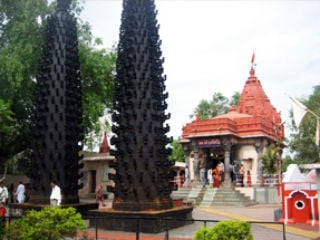 This temple occupies a special place in the galaxy of ancient sacred spots of Ujjain. Seated between the idols of Mahalaxmi and Mahasaraswati, the idol of Annapurna is painted in dark vermilion colour. The Sri Yantra, the symbol of power or shakti, is also enshrined in the temple.
This temple occupies a special place in the galaxy of ancient sacred spots of Ujjain. Seated between the idols of Mahalaxmi and Mahasaraswati, the idol of Annapurna is painted in dark vermilion colour. The Sri Yantra, the symbol of power or shakti, is also enshrined in the temple.
According to the Shiva Purana, when Shiva carried away the burning body of Sati from the sacrificial fire, her elbow dropped at this place. There is an interesting legend in the Skanda Purana about the manner in which the Goddess Chandi acquired the epithet of Harsiddhi. Once when Shiva and Parvati were alone on Mount Kailash, two demons Chand and Prachand tried to force their way in.
Shiva called upon Chandi to destroy them which she did. Pleased, Shiva bestowed upon her the epithet of ‘one who vanquishes all’. The temple was reconstructed during the Maratha period and the two pillars adorned with lamps are special features of Maratha art. These lamps, lit during Navaratri, present a glorious spectacle. There is an ancient well on the premises, and an artistic pillar adorns the top of it.
C. Shri Mangalnath Temple
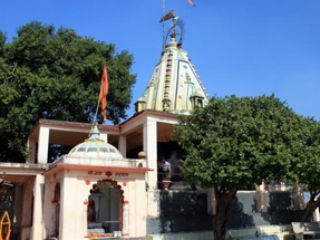 This temple is situated away from the bustle of the city and can be reached through a winding road. The temple looks upon a vast expanse of the Shipra waters and fills the onlooker with an indescribable sense of peace. Mangalnath is regarded as the birth place of Mars, according to the Matsya Purana. In ancient times, it was famous for a clear view of the planet and hence suitable for astronomical studies. Mahadev or Shiva is the deity which is worshipped in the temple of Mangalnath.
This temple is situated away from the bustle of the city and can be reached through a winding road. The temple looks upon a vast expanse of the Shipra waters and fills the onlooker with an indescribable sense of peace. Mangalnath is regarded as the birth place of Mars, according to the Matsya Purana. In ancient times, it was famous for a clear view of the planet and hence suitable for astronomical studies. Mahadev or Shiva is the deity which is worshipped in the temple of Mangalnath.
D. Shri Kaal Bhairav Temple
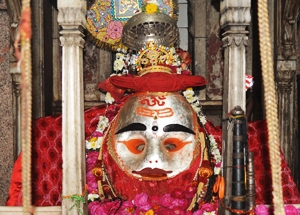 The worship of the eight Bhairavas is a part of Saivite tradition and the chief among them is Kal Bhairava, believed to have been built by King Bhadresen, on the banks of the Shipra. There is mention of a Kal Bhairva temple in the Avanti Khanda of the Skanda Purana. Worship of Kal Bhairava is believed to have been a part of the Kapalika and Aghora sects. Ujjain was a prominent centre of these two sects. Even today, liquor is offered as a part of the ritual to Kal Bhairava Beautiful paintings in the Malwa style once decorated the temple walls, only traces of which are visible.
The worship of the eight Bhairavas is a part of Saivite tradition and the chief among them is Kal Bhairava, believed to have been built by King Bhadresen, on the banks of the Shipra. There is mention of a Kal Bhairva temple in the Avanti Khanda of the Skanda Purana. Worship of Kal Bhairava is believed to have been a part of the Kapalika and Aghora sects. Ujjain was a prominent centre of these two sects. Even today, liquor is offered as a part of the ritual to Kal Bhairava Beautiful paintings in the Malwa style once decorated the temple walls, only traces of which are visible.
E. Navagraha Triveni (Shani Temple)
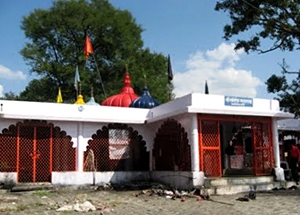 Situated on the Triveni Ghat of the Shipra, the temple is located away from the old site of Ujjaini town. It is dedicated to the nine planets, attracts large crowds on new moon days falling on Saturdays. Its religious importance has increased in recent years though there is no known reference to it in the ancient texts.
Situated on the Triveni Ghat of the Shipra, the temple is located away from the old site of Ujjaini town. It is dedicated to the nine planets, attracts large crowds on new moon days falling on Saturdays. Its religious importance has increased in recent years though there is no known reference to it in the ancient texts.
F. Gadhkalika Temple
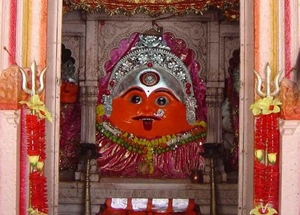 Situated about 2 miles from the city of Ujjain, the deity in this temple is believed to have been worshipped by Kalidasa. The legend goes that he was an idiot and it is by his devotion to the goddess Kalika that he acquired great literary skills.
Situated about 2 miles from the city of Ujjain, the deity in this temple is believed to have been worshipped by Kalidasa. The legend goes that he was an idiot and it is by his devotion to the goddess Kalika that he acquired great literary skills.
Emperor Harshavardhan had this temple renovated in the 7th century AD. There is further evidence of renovation during the Paramara period. The temple has been rebuilt in the modern times by the erstwhile Gwalior State.
G. Ram-Janardan Temple
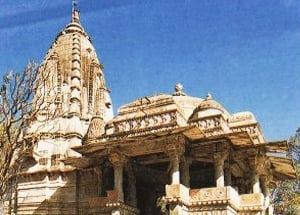 Idols of Rama; Lakshmana and Sita in the Rama-temple and that of Janardana-Vishnu in the Janardana-temple belong to the seventeenth century. Both the temples present an attractive look from the point of view of their structural art. These temples were constructed by Mirza Raja Jaisingh in the Seventeenth Century. The boundary wall and the tank were added later in Maratha Period in the eighteenth Century. Beautiful examples of maratha paintings are seen on the walls of both the temples. Besides the attractive scenes from the lives of Rama and Krishna, the painting of Bedalya Bua Maharaj and Sant Tukoba etc. are quite impressive.
Idols of Rama; Lakshmana and Sita in the Rama-temple and that of Janardana-Vishnu in the Janardana-temple belong to the seventeenth century. Both the temples present an attractive look from the point of view of their structural art. These temples were constructed by Mirza Raja Jaisingh in the Seventeenth Century. The boundary wall and the tank were added later in Maratha Period in the eighteenth Century. Beautiful examples of maratha paintings are seen on the walls of both the temples. Besides the attractive scenes from the lives of Rama and Krishna, the painting of Bedalya Bua Maharaj and Sant Tukoba etc. are quite impressive.
Certain old images are seen installed in both the temples as well as near the tank opposite Janardan temple which are very important from the point of view of sculpture also. The image of Govardhan dhari Krishna near the tank belongs to eleventh century. The images of Vishnu installed in between the assembly hall and the interior of Rama-temple belongs to the tenth century and the images of Brahma, Vishnu and mahesha belong to the twelth century A.D.
H. Shri Siddhwat Temple
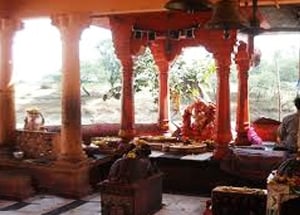 This enormous banyan tree on the banks of the Kshipra, has been vested with religious sanctity as the Akshayavat in Prayag and Gaya, Vanshivat of Vrindavan and the Panchavata of Nasik. Thousands of pilgrims take a dip in the Kshipra from the bathing ghat built here. According to one tradition, Parvati is believed to have performed her penance here. It used to be a place of worship for the followers of Natha sect. One legend has it that some Mughal rulers had cut off the Banyan tree and covered the site with iron sheets to prevent its roots from growing. But the tree pierced the iron sheets and grew and flourished. The little village of Bhairogarh near Siddhwat is famous for its tie and dye painting for centuries. In ancient times when trade with other countries flourished, exquisitely printed cloth from Bhairogarh used to find its way to Rome and China.
This enormous banyan tree on the banks of the Kshipra, has been vested with religious sanctity as the Akshayavat in Prayag and Gaya, Vanshivat of Vrindavan and the Panchavata of Nasik. Thousands of pilgrims take a dip in the Kshipra from the bathing ghat built here. According to one tradition, Parvati is believed to have performed her penance here. It used to be a place of worship for the followers of Natha sect. One legend has it that some Mughal rulers had cut off the Banyan tree and covered the site with iron sheets to prevent its roots from growing. But the tree pierced the iron sheets and grew and flourished. The little village of Bhairogarh near Siddhwat is famous for its tie and dye painting for centuries. In ancient times when trade with other countries flourished, exquisitely printed cloth from Bhairogarh used to find its way to Rome and China.
Reference : Sanatan Sanstha’s Holy text ‘Glory of the Kumbha Parva’ and Simhasth Ujjain

